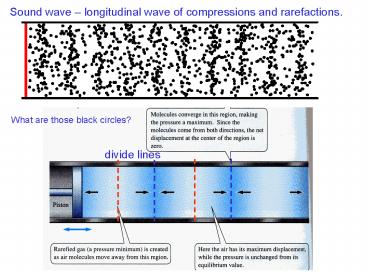Sound wave longitudinal wave of compressions and rarefactions' - PowerPoint PPT Presentation
1 / 16
Title:
Sound wave longitudinal wave of compressions and rarefactions'
Description:
... and wavelengths propagating in opposite directions interfere to make a composite ... an external driving force with a frequency close to that of the system. ... – PowerPoint PPT presentation
Number of Views:925
Avg rating:3.0/5.0
Title: Sound wave longitudinal wave of compressions and rarefactions'
1
Sound wave longitudinal wave of compressions
and rarefactions.
What are those black circles?
2
Pressure
Speeds of molecular motion of the collective
motion of the air of the sound wave.
Normal conversation speed of collective motion
45 mm/s. Amplitude 10 nm.
displacement
3
Reflection of a wave on string.
Full or partial reflection always occurs at a
boundary the wave cannot crossFor example, with
a medium, which does not support the waves of
that kind.Reflection depends a lot on the
boundary conditions a clamped string vs. a
freely sliding string.
4
Reflection of a wave on string.
A partial reflection always occurs if properties
of the medium change abruptly.Abruptly compared
to what?Examples reflection of sound off a
rock, light off a glass windowTwo connected
strings. What is different between them, F ? M
?How do the wave speed in them compare? What
about the amplitudes?
5
Refraction of waver waves
Refraction change in the direction of wave
propagation at a boundary.
Waves change direction, or refract, as they enter
shallow water, because the waves slow down.
6
Two waves of the same frequencies and wavelengths
propagating in opposite directions interfere to
make a composite standing wave.
Unlike the two interfering propagating waves, the
standing wave does not seem to go anywhere, just
like an oscillationBut it has all the
essential properties of the wavesspatial
structure, wavelength, wave number. It also has
amplitude and frequency just as the oscillations
do.
7
A longitudinal standing wave
8
How do you create a standing wave? Make a
traveling wave interfere with its reflection off
some boundary!
There are some points, nodes, N, where the string
does not move at all.There are other points,
antinodes, A, where the oscillations have the
maximum amplitude.
How far apart are those nodes and antinodes?
9
We normally consider standing waves in a confined
space, like on string clamped on both sides.It
imposes some boundary conditions, which have to
be matched by all standing waves, which are
allowed.
10
A propagating wave on a string can have any
frequency/length.In contrast, stable standing
waves on a string can only have some discrete,
well defined wavelengths and frequencies.How
many different wavelengths are allowed? What is
the smallest/largest one?
11
Some mathlargest wavelength / lowest frequency
Higher harmonics, wavelengths
Higher harmonics, frequencies
12
Some mathlargest wavelength / lowest frequency
Fundamental mode
Higher harmonics
13
More mathinterference
Composite wave
14
Standing waves in 2D systems
15
Resonance - a vibration of large amplitude in a
mechanical or electrical system caused by a
relatively small periodic stimulus of the same or
nearly the same period as the natural vibration
period of the system.Requires ? a system
capable to vibrate with a reasonable small
damping? an external driving force with a
frequency close to that of the system.
http//www.youtube.com/watch?vYLBt_07-Vek
16
Questionwhy are we discussing resonance now and
have not discussed it while talking about
propagating waves?
Propagating waves do not have any special natural
wavelengths and frequencies.Both wavelengths
and frequencies can vary continuously.Standing
waves have a particular set of allowed
frequencies, which are characteristic for the
system.
Fundamental mode
Higher harmonics































